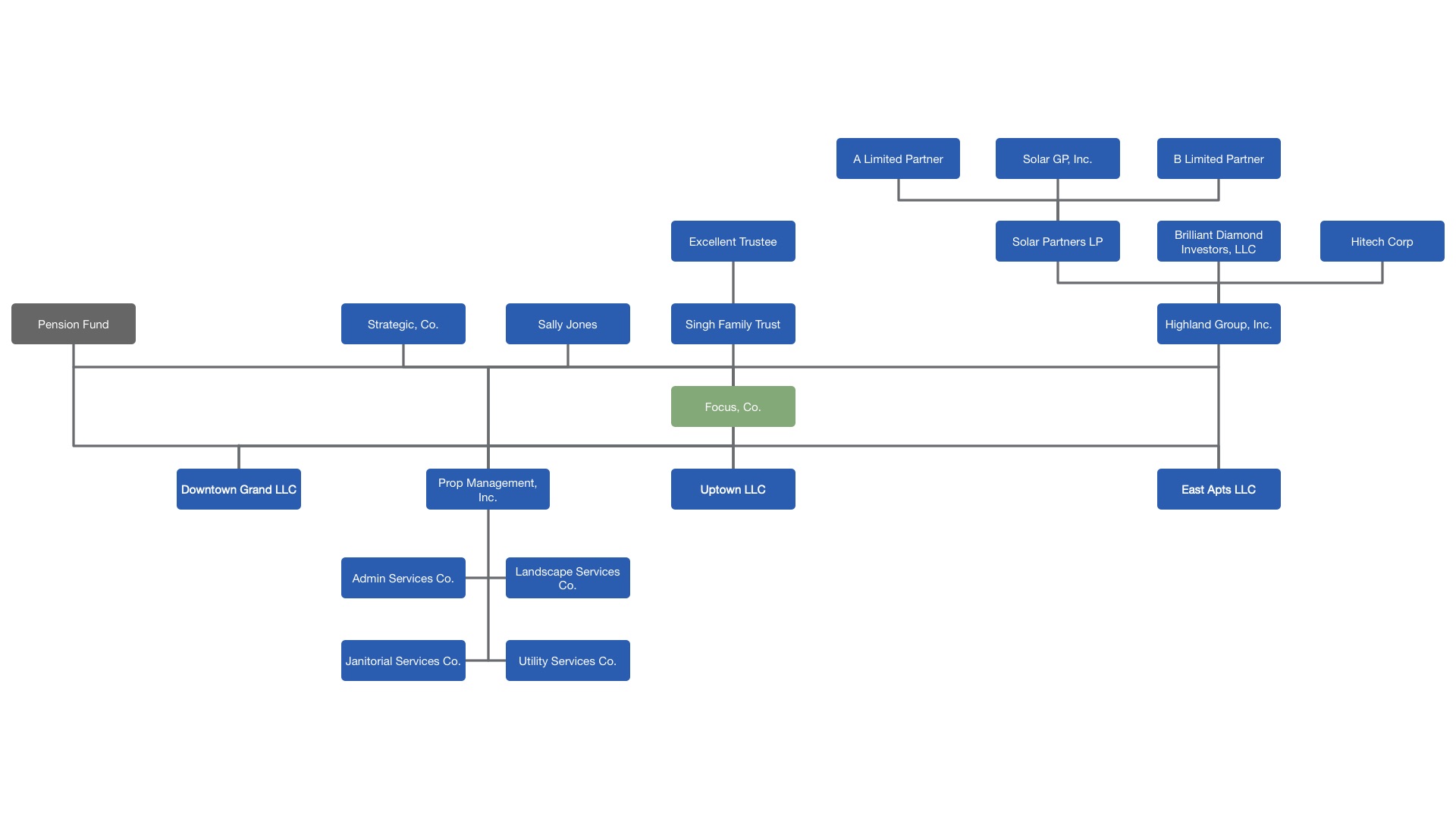Company Org Charts - Quick Tips for Lawyers
Updated:

Company organization charts are complex and messy. They are critical to business lawyers and corporate counsel serving due diligence, compliance, governance, mergers and acquisitions, and other legal needs.
Just looking for a company org chart solution? Check out Lexchart, our org chart software. Lexchart is a powerful tool for creating and managing company org charts. It is separate from our entity management software, Lextree.
To create an org chart, follow these steps:
- Capture ownership data from documents.
- Focus on direct parents and subsidiaries only.
- Have an application calculate all current ownership relationships.
- Display dynamic org chart.
- Review the org chart to ensure proper hierarchy and generation skipping.
The result looks something like this.

What is the difference between Company and Management Org Charts?
A company organizational chart differs from a management organizational chart. Company organizational charts show the owner relationships between legal entities in the corporate family. A management chart, on the other hand, is a picture of managers and staff within a single company or department. A management org chart illustrates the reporting relationships among individuals.
Both types of charts are useful. Company org charts, however, are critical to business lawyers and corporate counsel.
A company org chart must show the ownership relations among legal entities. Even simple org charts, need to accommodate the full range of corporate forms: limited liability companies (LLCs), corporations (S and C), partnerships (GPs, LPs, LLPs, and LLPs), individuals, and more. A legal org chart will show owners regardless of type.

Three Benefits of Company Organizational Charts (more than a pretty picture)
There are three benefits to legal entity org charts. An effective org chart:
- Displays information density: large amounts of ownership data are available as a single graphic.
- Reveals corporate tracking failures: each entity should be in the lawyer’s legal entity management system.
- Improves client relationships: both corporate counsel and outside business lawyers need effective ways to communicate with clients. Org charts are a rare, meaningful visualization of legal data for clients.
Challenges of Company Organizational Charts
Unlike most management org charts that are shaped like a pyramid, company org charts vary widely in their shape. Often the most simple company org charts are inverted pyramids, because they show a single entity at the bottom with multiple owners across the top.
The entity in focus can own other legal entities (Subsidiaries), which the org chart places below the entity in focus. Those subsidiaries can own other subsidiaries in turn, and so on.
Some businesses look more like a column with few owners and many layers of ownership. Other businesses are short and wide, with few layers and many owners. And some entities are indistinguishable from a ball of yarn.
The other major complexity is that ownership can flow in the opposite direction. A subsidiary can have ownership in a parent company in the org chart. It is almost never the case in a management org chart that a subordinate staff member has authority over someone senior in the management chain. The flexibility of legal ownership means that this is possible for business entities.
Organizational charts need to accommodate this idiosyncrasy of legal entities generally. The vast majority of corporate organizational charts, however, draw ownership lines incorrectly. Org charts mistakenly draw every line connecting two entities directly into the top center of the secondary entity. There are two problems with the approach. It fails to show generation skipping and inverted subsidiary ownership of an entity above in the org chart.
- Generation skipping is where an entity two or more levels up in the corporate family owns an entity alongside its own subsidiary.
- Inverted subsidiary ownership is a case where an entity lower in the corporate structure has an ownership interest in an entity higher in the org chart.
Most org charts do not account for these types of situations because the ownership line follows the same path as normal ownership lines. Company org charts can solve this problem with an algorithm that places lines on the sides as well as the tops of legal entities. In practice, this is rare.
How Not to Make a Company Organizational Chart
Most lawyers, paralegals, and legal assistants draw company organizational charts by hand. They might use charting software like Microsoft Visio, or presentation software, like Microsoft PowerPoint.
There are several downsides to hand drawn org charts. First, applications like Visio are good general purpose applications with many more features than most legal professionals have time to master. There is definite trade off between power and usability.
Second, presentation or word processing software, like PowerPoint or Word suffer from too little functionality, even though their features are familiar to most lawyers.
Third, hand drawn charts in general capture the ownership structure at a point in time only. The moment a single share of stock is sold, a partnership interest is conveyed, or a member joins the LLC, the company org chart is inaccurate and misleading.
How to Make a Company Org Chart
A better approach is to use legal entity management software to generate company organizational charts dynamically. Legal entity solutions capture equity ownership data about each entity, then calculate the ownership relationships for timely and accurate presentation in the org chart.
The best legal entity management solutions go a step further by presenting generation skipping relationships and inverted ownership structures clearly.